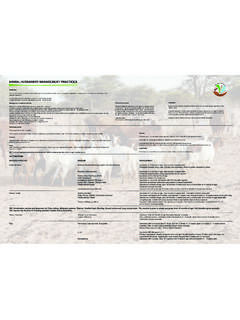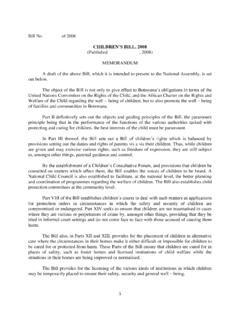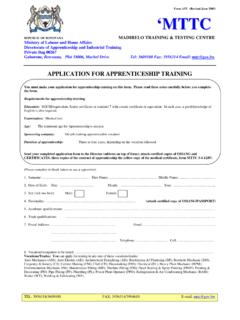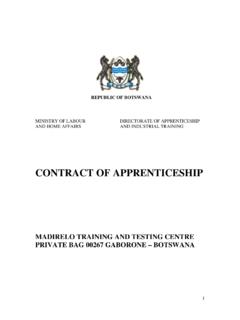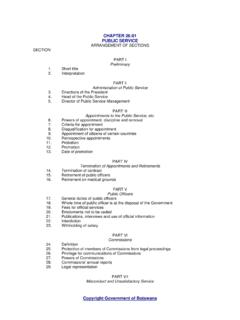Transcription of SMALLSTOCK MANAGEMENT INTRODUCTION - …
1 1 SMALLSTOCK MANAGEMENT INTRODUCTION The sheep and goat kept in Botswana, to a hot, often dry, environment with cold winter nights and have developed resistance to local diseases and parasites such as tick-bone disease (notable heartwater) and internal parasites. In this environment, the survival and production of the Tswana breeds is better than that of imported breeds such as boer goats and Dorper sheep. In Botswana, controlled breeding is generally not practiced, however, most kidding and lamping occurs in the winter/dry season (July to September). Does kidding in May/June have significantly higher reproductive rates than those kidding in October/November but mortality rates from birth to weaning are significantly higher in kids born in May/June. Goats Goats are valuable not only for providing meat and milk but are also useful for controlling bush encroachment.
2 Tswana goats frequently produce twins but when pregnancy occurs during the winter/dry season, birth weights of the kids can be low (less than 2kg). This affects high chances of survival. Males can reach slaughter age at 12 months; females are ready for breeding at 10 months and have a reproductive life of at least five years. Boer goats grow faster, are heavier and are more prolific than Tswana goats. Sheep Tswana sheep frequently produce twins and performs better than imported breeds under conditions found in Botswana. Though in Botswana goat meat is preferred to sheep meat, lamb and mutton is in demand in other countries and could become a valuable export. Sheep are primarily grazers and goats are principal browsers, together they make best use of the feed resource available. Herd and flock MANAGEMENT The kraals should contain separate pen for the kids and lambs.
3 SMALLSTOCK should not be released (before 11am) earlier than mid morning because they can travel too far and may not return before sunset and will be at risk of being taken by predators. Young kids and lambs are kept in the kraals while their dams graze and browse in the day time, taking milk before they leave and after they return. Normally three to four breeding males are kept per 100 females and surplus males may be castrated. Weights of lambs and kids born are significantly higher when born at the end of the wet season rather than at the end of the dry season. Kid and lamb mortality is high due to a combination of mothering ability, cold weather and poor MANAGEMENT among others. Mortality during the first few days after birth is a particular problem in goats, accounting for 35% of all kids deaths. One of the main reasons for this is separation of mother and kid during the first few hours after birth.
4 Ram /Buck MANAGEMENT Supplementary feed should be provided when required, deworming and attending problems like overgrown feet. A ratio of rams/bucks to ewes/does should be at least 1:30 and preferably 1:25. It is good to keep more males than minimum required in case one or more are infertile. A young ram/buck should not be used until it is two thirds of its adult size and at least one year old. 2 Timing the INTRODUCTION of rams/bucks The owner of SMALLSTOCK can make decision on when lambing and kidding occurs if males are separated from the rest of the flock/herd to stop mating until the desired time. The two mating strategies can be considered: 1. Introduce rams/bucks in September October: lambs/kids born in February-March; Advantage Plenty of feed in pregnancy and early lactation provides milk in abundance and rapid growth of kids/lambs.
5 Disadvantages Does/ewes in poor condition at time of mating so conception rate is low; Challenge from internal/external parasites to lambs/kids is high; Availability of forage declines before weaning. 2. Introduce rams/bucks March-April: lambs/kids born August September. Advantages Does/ewes in good condition at time of mating hence high conception rate; Offspring born at time of low incidence of internal and external parasites; Browse available at weaning time. Disadvantages Poor nutrition in late pregnancy resulting in abortion in goats and birth of weak offspring; Cold weather at time of birth resulting in neonatal mortality; Slow growth rates of lambs and kids because ewes/does have poor milk supply; Slow growth rates of lambs and kids due to lack of grazing and browse. Ram/buck examination before using for mating Rams and bucks should be examined regularly for health and their ability to mate.
6 If the ram or buck is to mate satisfactorily it should be healthy and not too thin. It should not have a cough, diarrhoea, or lameness. There should be no skin or foot lesions or purulent discharges from nose and eyes. All teeth of the male should be present. It is an advantage to keep bucks with dark skin pigmentation to avoid skin disease like photosensitization and skin tumours in the offspring and should have good conformation. The reproductive organs should be examined. 3 Ewe/doe MANAGEMENT Females should be examined and those which are not fit to breed should be culled. Young females should have reached at least three quarters their adult size and body weight (at least 10 months) before being bred for the first time. Most rapid growth of the foetus and greatest demands on the dam are in the last third of pregnancy.
7 Lack of quality feed at that time will result in low birth weights and weakness of the lambs/kids. MANAGEMENT of the newborn lamb/kid An early intake of colostrum protects the newborn animal from infectious disease and increases its chances of survival. The lamb or kid at birth has no immune defence against infections. The ewe/ram is able to concentrate antibodies in the colostrums. Colostrum is also a rich source of energy. Abortion When an animal aborts, its discharges, its aborted foetus and foetal membranes (afterbirth) may be infective to other SMALLSTOCK and also to the stockman and his family. Toxoplasma abortion Toxoplasmosis is the most common cause of the infectious abortion identified at Botswana Veterinary Laboratory. This disease is spread by domestic cats and wild members of the cat family.
8 The causal organism is a coccidial parasite which lives in the gut of cats and its oocysts (eggs) are passed out in the faeces of cat. Prevention and control Efforts are concentrated on preventing pregnant animals coming into with faeces of cats and other felines. Lameness Remove any thorns from feet and stones which may have lodged between the toes. Remove ticks which may be attached between the toes or apply tick grease to kill them. Pave away with a sharp knife or hoof shears any overgrown or under-run hoen on the hooves. Mastitis When SMALLSTOCK get mastitis, by the time is observed it is often too late to save the gland. Separate the ewe/kid and treat with a broad spectrum antibiotics intramuscularly. Tetracyclines are also useful. Heartwater Heartwater appears to be the foremost constraint to small stock production in the areas of hardveld.
9 This is because the bont tick which carries the disease heartwater is found in the Hardveld. The rickettsia causing heartwater is susceptible to tetracyclines and if affected livestock are treated early they will recover. 4 Control Owners are encouraged to treat their SMALLSTOCK with acaricides by dipping and spraying as often as once weekly. Intestinal worms Sheep and goats are infected by eating larvae which are on the grass they graze. When the larvae get into the gut they become adult worms. Clinical signs Animals suffering from intestinal worms are thin and weak. They may be anaemic. There is one very important intestinal parasite called Haemonchus. It lives in the stomach where it sucks blood. Treatment The best time to treat small stock for intestinal worms is usually at the beginning of the rains. It is often necessary to treat those which show signs of thinness, anaemia and diarrhoea.
10 Liver fluke Liver fluke are leaf like parasites which live in the bile ducts of the liver and pass out their eggs into the gut with bile and into the faeces. Clostridial disease Clostridial diseases can cause rapid death. Clostridial diseases known in Botswana are; lamb dysentery, struck, tetanus and black leg/malignant cedema. Vaccination Clostridial diseases are widespread and vaccines against them are potent and cheap, so their use is sensible and cost effective. Multivalent vaccines (7 in 1 and 8 in 1) are available. If clostridial disease is a particular problem in a flock/herd, animals should receive a booster vaccination every six months. Pasteurellosis Pasteurellosis causes pneumonia or septicaemia in adult sheep and goats and septicaemia in young lambs and kids. Treatment and control Pasteurella pneumonia may be treated with antibiotics.
